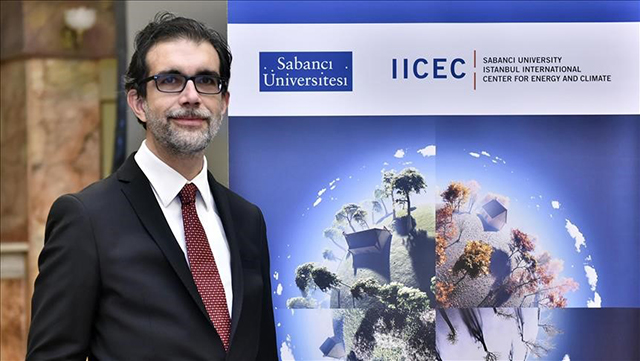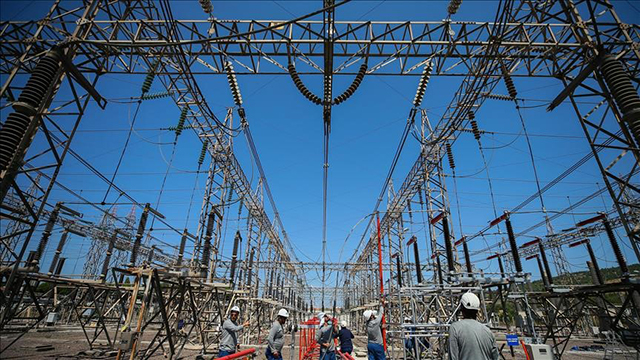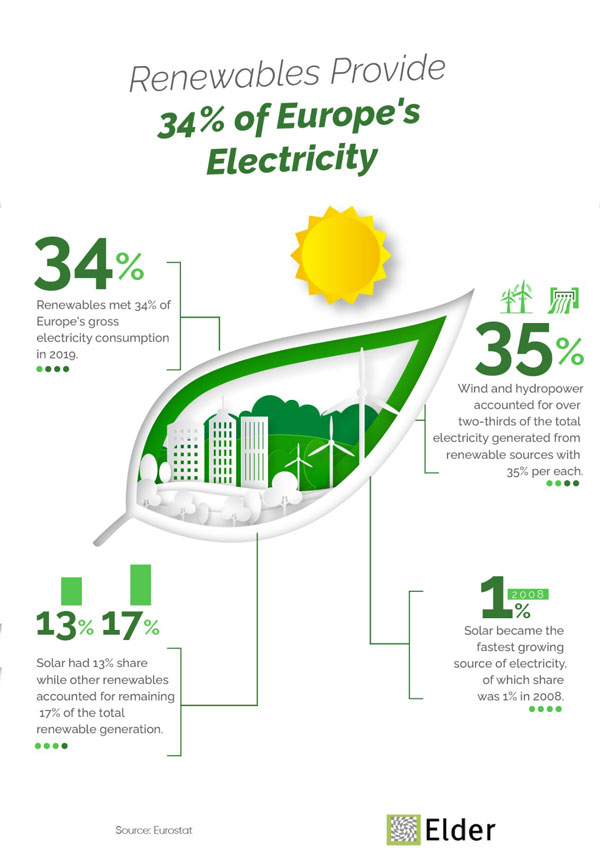
Turkey's energy efficiency measures and investments have saved the country $1 billion (TL 7.44 billion) between 2017-2019, Energy and Natural Resources Minister Fatih Donmez said on Wednesday.
Donmez’s remarks came in his address at an online conference titled Renewable and Smart Energy Applications in Municipalities, organized by the Union of Municipalities of Turkey (TBB).
The minister said Turkey’s energy intensity, a measure of the energy inefficiency of an economy calculated as units of energy per unit of the gross domestic product (GDP), is higher than developed countries, such as Germany and Japan, and stands above the average of Organisation for Economic Co-operation and Development (OECD) countries.
If Turkey is to achieve its aim of becoming one of the world's top 10 economies it must decrease its energy intensity, boost energy efficiency and fully utilize its own resources, he said.
Stressing the importance of energy efficiency, Donmez emphasized that this efficiency was responsible for the 1,000 MegaWatts capacity of power production from 10 plants.
The annual contribution of local and renewable energy resources to Turkey's economy amounts to nearly $100 million, he said. The renewal of the country's regulations pertaining to rooftop solar PV installations will allow for their greater expansion with the support of local authorities, whom Donmez describes as key shareholders in energy efficiency efforts.
To further bolster renewables, Donmez announced that there was no longer a limit on unlicensed power production, which had been capped at 5 MegaWatts.
“From now on, municipalities are now allowed to produce the renewable energy they need, including solar, depending on the power levels of the electrical connection,” he said. He added that local authorities would be able to sell the surplus energy produced and generate additional income.
Source: Anadolu Agency

Turkey's power demand is forecast to be the fastest growing among other energy types, accounting for 30% of total final energy demand by 2040, director of Sabanci University Istanbul’s International Center for Energy and Climate (IICEC), told Anadolu Agency on Wednesday.
Electricity demand currently represents 20% of Turkey’s total energy demand, according to the IICEC's recently published Turkey Energy Outlook report analyzing the Turkish energy sector through to 2040. "Turkey's final energy demand will grow by around 40% by 2040 while electricity demand will be around 70% to 90% during the same period. With this increase, the share of electricity demand in final energy demand will reach 30%, as electricity is seeing the fastest growth among other energy types," Bora Sekip Guray, the IICEC director said.
He cited Turkey's young population, its developing industry and increasing electrification as the main contributing factors for this power demand increase.
Therefore, Guray advocated for investment growth in both Turkey’s electricity sector, which he said needs to be in region of around $8 billion by 2040, and also in the renewable energy sector. According to the IICEC's studies, solar and wind currently hold an 11% share in Turkey's total energy generation but this share is forecast to increase to 36% by 2040. "Considering the contribution from other renewables including hydro, geothermal and biomass, the share of renewables in total electricity generation will reach 60%," he said, adding that a growth in domestic and renewable capacity would help Turkey reduce its energy import bill and support the local manufacture of clean energy technologies.
Turkey's installed renewable energy capacity of 49,500 MegaWatts accounts for more than half of the total installed electricity capacity of 95,000 MegaWatts.
- Natural gas and energy storage will still be central for energy sector’s future Even though the share of natural gas plants in Turkey’s electricity generation dropped dramatically from 50% in the last few years to the current 20%, thanks to the growth of renewable, natural gas plants are nonetheless set to continue to play a crucial and balancing role in bridging the power supply gap by offering flexible power when renewable generation is insufficient.
Guray argued that energy storage technologies could also provide similar supply flexibility.
"We see a number of investment opportunities for energy storage technologies in Turkey. Turkey's first indigenous and all-electric automobile prototype will contribute much to the development of energy storage technologies and investments in Turkey," he said.
In June 2018, five industrial giants: the Anadolu Group, BMC, Kok Group, Turkcell, and Zorlu Holding as well as an umbrella organization, the Union of Chambers and Commodity Exchanges of Turkey, joined forces to form Turkey's Automobile Joint Venture Group (TOGG) to produce Turkey's first domestically manufactured electric vehicle.
By 2030, TOGG will produce and own the intellectual and industrial property rights of five different electric vehicle (EV) models in Turkey- SUV, b-SUV, sedan, c-hatchback, and b-MPV. Turkey inaugurated the first Eti Maden Lithium Production Plant in the country's central province of Eskisehir last month. The lithium from the production plant will be used in components for these EVs.
Guray also maintained that the share of local sources for power generation would increase after Turkey's first nuclear plant becomes operational and the country begins using its natural gas production from the Black Sea region.
Turkey discovered a total of 405 billion cubic meters of natural gas in the Black Sea region in 2020 and first production from the field is planned to start by 2023.
Source: Anadolu Agency

The International Energy Agency today announced that it will produce the world’s first comprehensive roadmap for the energy sector to reach net-zero emissions by 2050 as it further strengthens its leadership role in global clean energy transitions.
The new special report, The World’s Roadmap to Net Zero by 2050, will set out in detail what is needed from governments, companies, investors and citizens to fully decarbonise the energy sector and put emissions on a path in line with a temperature rise of 1.5 degrees Celsius. It is part of a series of new IEA projects to support efforts to reach global energy and climate goals.
This new roadmap will be released on 18 May and build momentum ahead of the COP26 Summit in Glasgow in November, under the presidency of the United Kingdom. Dozens of countries – including most of the world’s largest economies – and many leading companies have already announced plans to bring their emissions down to zero by around the middle of this century.
But much work remains to be done to translate these ambitious targets into actual reductions in emissions. “The energy that powers our daily lives and our economies also produces three-quarters of global emissions. This means our climate challenge is essentially an energy challenge. The IEA is determined to tackle that challenge and lead global clean energy transitions,” said Dr. Fatih Birol, the IEA’s Executive Director.
“Our roadmap to net zero can play a vital role in helping countries identify and implement the actions needed to achieve climate, energy security and affordability goals. Nothing short of a total transformation of our energy infrastructure will be required. That calls for decisive action this year, next year and indeed every year to 2050,” Dr. Birol said.
COP26 President Alok Sharma said: "The IEA’s plan to produce a pathway to net zero global emissions by 2050 is another important step for climate action. This will make clear the actions countries must take individually and collectively to meet that goal.” Driving a stronger global consensus on the pathway to net zero will be a key priority for the IEA over the coming years.
The Agency also intends to step up its work on global clean energy transitions in other major areas through 2021 and beyond. It will expand efforts to support its members and partners in meeting their climate ambitions, and play a greater role in tracking national commitments. This includes working with governments to develop stronger mechanisms that build confidence that they are not alone in taking the necessary steps to keep their climate promises.
The IEA also announced that reinvigorating international energy cooperation will be a major theme of the 2nd IEA Clean Energy Transitions Summit, following the first event held last year. This year’s Summit will be co-hosted with the UK Government on 31 March and will focus on how governments can work together more effectively to ensure long-term net-zero targets are translated into concrete action in the run up to COP26.
Source: International Energy Agency

The environment is an important focus for 2021 and is already being positioned as an opportunity for accelerating the business and policy transition to net-zero, according to a new report released by consulting firm PwC. PwC’s Global Economic Outlook 2021 states that significant investment and policy shifts related to the Paris Climate Agreement will be made in 2021 in the major trading blocks including the US, China and the EU.
With the global economy having shrunk in 2020 due to COVID-19, a key theme in 2020 will be how the push for recovery and growth can synchronise green infrastructure investment, creating a turning point in the fight against climate change. Globally, the call for countries to expand their portfolio of renewable energy resources will gather momentum. Solar photovoltaic capacity is to grow at rapid rates on the back of growing capacity in the EU, India and China.
If current trends continue, solar PV capacity is on course to surpass natural gas in 2023 and coal in 2024 in the global electricity sector, according to PwC.
Green bonds, which are used to directly finance environmental projects, currently make up less than 5% of the global fixed income market. In 2021, total green bond issuance will increase by over 40% to top half a trillion US dollars for the first time.
This trend is further likely to be helped by the EU Green Bond Standard, which is expected to bring a level of standardisation to these financial instruments. In addition, investor appetite for Environmental, Social and Governance (ESG) funds will continue to increase and could account for up to 57% of total European mutual funds by 2025.
Barret Kupelian, senior economist at PwC, said: “While it’s good news that the global economy in aggregate is likely to be back to its pre-crisis levels of output by the end of 2021 or early 2022, a distinguishing feature of the Great Rebound is that it will be uneven across different countries, sectors and income levels. For example, the Chinese economy is already bigger than its pre-pandemic size, but other advanced economies ‒‒ particularly heavily service based economies like the UK, France and Spain or those focused on exporting capital goods, such as Germany and Japan ‒‒ are unlikely to recover to their pre-crisis levels by the end of 2021.”
Source: Smart Energy International

Researchers in the Netherlands and Singapore have measured irradiance-weighted average temperatures of floating PV systems in both countries and have compared the results with reference rooftop and ground-mounted PV systems. They have discovered that floating PV systems with open structures, which allow wind to pass beneath the modules, can provide a higher heat loss coefficient.
The cooling effect of water in floating PV systems can be increased in tropical and temperate maritime climates if a proper system design allows for more wind to flow between the modules and the water surface. This is one of the main findings of a recent research project conducted by the Netherlands Organisation for Applied Scientific Research (TNO) and the Solar Energy Research Institute of Singapore (SERIS).
Scientists from both organizations have jointly assessed the irradiance-weighted average temperatures (IWATs) of floating solar arrays in the Netherlands and Singapore and have compared the results with those of ground-mounted installations and rooftop PV systems. The test field in the Netherlands was located on an inland lake close to the sea in the province of South-Holland. The test bed in Singapore was at a 1 MW floating solar array on the Tengeh Reservoir. In the former, two kinds of floating systems were tested: one with a small footprint on water and an open structure (NL1), and one with a large footprint on water and a closed structure (NL2). In the latter, three different systems were investigated: an array with a large footprint and closed structure (SG1), a system with a medium footprint and closed structure (SG2), and a free-standing system with an open structure (SG3).
The performance and temperature behavior of the NL1 and NL2 arrays was compared to those of two reference ground-mounted installations. The scientists called them NL 3 and NL 4. They also compared the energy yield of the three systems in Singapore with the yield from a free-standing rooftop PV system (SG4).
The measurements showed that the irradiance-weighted average temperature (IWAT) of the NL1 system in the Netherlands, which was the best performing system, was 3.2 C lower than the nearby reference system. In Singapore, the best-performing system was the SG3 array, which exhibited a 14.5 C lower IWAT than its reference system. Furthermore, the determined heat loss coefficients of the different systems have been used within PVsyst software to model the annual yield of the floating systems and the reference arrays in a typical meteorological year.
In Singapore, the best-performing system was the SG3 array, which exhibited a 14.5 C lower IWAT than its reference system. “The determined median heat-loss coefficients of the best-performing systems NL1 and SG3 are with 57 W/m2 per kelvin and 55 W/ m2 per kelvin, respectively, almost identical,” the researchers concluded. “When the heat-loss coefficients of all systems are split into a constant value and a wind-dependent value, and using these values to model the specific yield of all systems, it can be concluded that the largest part of the cooling effect of FPV systems can be attributed to higher wind speeds above water compared to land.”
They also said that the floating systems with the open structure, which allow for wind beneath the modules, can provide a heat loss coefficient that is up to 22 W/m2 per kelvin higher compared to the reference systems. The scientists described the floating PV systems and their performance in “the cooling effect of floating PV in two different climate zones: a comparison of field test data from the Netherlands and Singapore”, which was recently published in Solar Energy.
Source: Pv Magazine

A spell of cold temperatures last week revealed a mismatch between the U.K.’s goal to decarbonize and actions taken in order to keep the lights on. Low wind output was a factor that caused the narrowing of margins between supply and demand of electricity according to National Grid Plc. Instead of using the cheap wind generation available, on the afternoon of Jan. 6, one of the U.K. biggest wind farms switched off, while National Grid paid an Electricite de France SA gas plant 3,000 pounds ($4,071) per MegaWatt-hour to produce power.
The actions show the difficulties of delivering ambitious climate policies as well as preventing blackouts. That said, Britain’s power system is getting cleaner. Last year was the greenest year on record according to the network operator. For every KiloWatt-hour of electricity the U.K. generates, it now produces 60% fewer carbon emissions than 2013. As more parts of the economy electrify, utilities and trading houses are expanding to find an edge in Europe’s $430 billion power market. Last week’s activity shows that trading can come at the expense of what’s best for the climate. National Grid takes these decisions in the balancing market, a part of the power system where the grid operator fine-tunes supply and demand. The cost of balancing the power system jumped last year as the pandemic hit demand -- now it’s struggling with low wind, outages at nuclear plants and a prolonged cold snap.
“In the future prices will become more extreme at certain points – either super-high prices like last week or super-low prices when renewables are running at maximum output,” said Phil Hewitt, director of Enappsys Ltd. In the balancing market, generation that isn’t already running can offer its output into the market or get paid to switch off. National Grid tries to find the most economic way to get what it needs to keep the system balanced, a spokesperson for the company said.
Separately there was low availability from EDF’s nuclear fleet including a unit at Heysham-1 that was due to return to the grid last week but didn’t switch on. That helped create conditions that allowed EDF to secure the high price granted to its gas plant. Wind farms can also be asked to turn down when a surge of electricity threatens to overwhelm the grid. However, that wasn’t the case with SSE Plc’s 588-MegaWatt Beatrice wind farm on Jan. 6. The site, one of the country’s biggest offshore wind farms and capable of powering about 450,000 homes, has a so-called contract for difference to sell power for about 162 pounds per MegaWatt hour, about four times the average market price for power. If the market price for power goes above the contract price, then the wind farm owner is meant to pay the difference back.
The contracts, which are a government subsidy, were critical to scale up the offshore wind industry by giving developers certainty while also cutting costs for consumers. The idea is that once wind farms are cheap enough, they won’t need support. But last week showed that the contracts won’t always work as planned. Day-ahead power traded for Wednesday evening surged to 1,000pounds per MegaWatt hour. If the Beatrice wind farm sold power then, it would have to pay back 837 pounds per hour for every unit of electricity produced.
Source: Bloomberg
Net Zero Carbon Cities: An Integrated Approach
According to World Economic Forum’s report, cities cover 3% of the earth’s land surface yet they create more than 70% of all carbon emissions. To keep global temperature increases to 1.5°C or below, cities have to achieve net-zero.
Please click here to read the full report.
EMRA & ELDER & ODTU TEKNOKENT Energy is You Enterpreneurship Program
20 January 2021
Global DSO Event
26 - 27 January 2021
Eurelectric- e-vision: Accelerating Fleet Electrification
2 - 3 February 2021
11. Turkey Energy Summit
10 - 12 October 2021
14. EIF World Energy Congress and Expo
13 - 15 October 2021
Solarex Istanbul
01 - 03 April 2021
8th International Istanbul Smart Grids and Cities Congress and Expo (ICSG 2021)
04 - 05 June 2021
European Utility Week (Enlit Europe)
30 November - 2 December 2021

